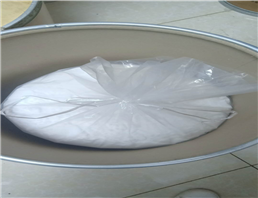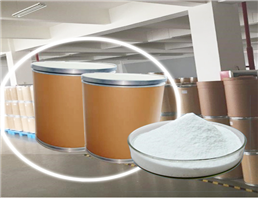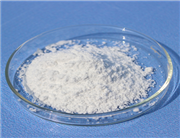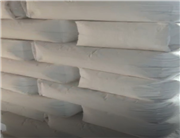【Name】Trometamol, Tris
【Abbreviation】Tris
【CAS#】77-86-1
【Molecular Weight】121.135
【Molecular formula】C4H11NO3
【Specification】25kg/barrel
[Storage conditions] Room temperature, avoid light and moisture
【Appearance】White crystal powder
[Uses] Used in the preparation of buffers in biochemistry and molecular biology experiments; pharmaceutical intermediates; used in the preparation of surfactants and vulcanization accelerators; preparation of water-soluble polymers containing Tris structural units as coating dispersants; Preparation of indoor formaldehyde adsorption materials, etc.
[Specific application] Tris is often used as a biological buffer, and is often formulated with pH values of 6.8, 7.4, 8.0, and 8.8. Its structural formula and pH value vary greatly with temperature. Generally speaking, for every degree of temperature increase, the PH value drops by 0.03.
Tris is widely used in the preparation of buffers in biochemistry and molecular biology experiments. For example, TAE and TBE buffers (used for the dissolution of nucleic acids) commonly used in biochemical experiments require Tris. Because it contains amino groups, it can undergo condensation reactions with aldehydes.
Tris is a weak base, and its pKa is 8.1 at room temperature (25°C); according to the buffer theory, the effective buffer range of Tris buffer is between pH 7.0 and 9.2.
The pH of the aqueous solution of Tris base is around 10.5. Generally, hydrochloric acid is added to adjust the pH to the desired value to obtain a buffer of this pH. However, attention should be paid to the influence of temperature on the pKa of Tris.
Since the Tris buffer is a weakly alkaline solution, DNA in such a solution will be deprotonated, thereby improving its solubility. People often add EDTA to Tris hydrochloric acid buffer to make "TE buffer", which is used for DNA stabilization and storage. If you change the pH-adjusting acid solution to acetic acid, you get "TAE buffer" (Tris/Acetate/EDTA), and change to boric acid to get "TBE buffer" (Tris/Borate/EDTA). These two buffers are commonly used in nucleic acid electrophoresis experiments.
TAE and TBE prepared by Tris are the most commonly used reagents for DNA electrophoresis, and TE (pH 8.0) is mainly used to dissolve DNA. (TE is the collective name of Tris plus EDTA.) 1M Tris-HCl 6.8 and 1.5M Tris-HCl 8.8 are the most commonly used reagents for SDS-PAGE. (The specific configuration method is as follows):
1 M Tris-HCl (pH7.4, 7.6, 8.0)
Component concentration 1 M Tris-HCl
Preparation volume 1L
Preparation method
1. Weigh 121.1 g Tris and place it in a l L beaker.
2. Add about 800 ml of deionized water, stir well to dissolve.
3. Add the amount of concentrated HCl in the following table to adjust the required pH value.
pH value Concentrated HCl
7.4 Approximately 70 ml
7.6 About 60 ml
8.0 About 42ml
4. Dilute the solution to 1 L.
5. After autoclaving, store at room temperature.
Note: The pH value should be adjusted after the solution is cooled to room temperature, because the pH value of the Tris solution varies greatly with temperature, and the pH value of the solution decreases by about 0.03 units for every 1°C increase in temperature. 1.5 M Tris-HCl (pH8.8)
Component concentration 1.5 MTris-HCl
Preparation volume 1 L
Preparation method
1. Weigh 181.7 g Tris in a 1 L beaker.
2. Add about 800 ml of deionized water, stir well to dissolve.
3. Adjust the pH to 8.8 with concentrated HCl.
4. Dilute the solution to 1 L.
5. After autoclaving, store at room temperature.
Note: The pH value should be adjusted after the solution is cooled to room temperature, because the pH value of the Tris solution varies greatly with temperature, and the pH value of the solution decreases by about 0.03 units for every 1°C increase in temperature. Tris buffer is not only widely used as a solvent for nucleic acids and proteins, but also has many important uses. Tris is used for protein crystal growth under different pH conditions. The low ionic strength of Tris buffer can be used for the formation of the intermediate fiber of C. elegans nuclear lamin (lamin). Tris is also one of the main components of protein running buffer. In addition, Tris is also an intermediate for the preparation of surfactants, vulcanization accelerators and some drugs. Tris is also used as a titration standard.
[Buffering characteristics] Tris is a weak base, and its pKa is 8.1 at 25°C; according to the buffering theory, the effective buffering range of Tris buffer is between pH 7.0 and 9.2. The pH of the aqueous solution of Tris base is around 10.5. Generally, hydrochloric acid is added to adjust the pH to the desired value to obtain a buffer of this pH. However, attention should be paid to the influence of temperature on the pKa of Tris.
[Configuration of Tris buffer]
|
Required PH value (25℃)
|
7.10
|
7.20
|
7.30
|
7.40
|
7.50
|
7.60
|
7.70
|
7.80
|
7.90
|
8.00
|
8.10
|
8.20
|
8.30
|
8.40
|
8.50
|
8.60
|
8.70
|
8.80
|
8.90
|
|
0.1mol/L HCI volume
|
45.7
|
44.7
|
43.4
|
42
|
40.3
|
38.5
|
36.6
|
34.5
|
32
|
29.2
|
26.2
|
22.9
|
19.9
|
17.2
|
14.7
|
12.4
|
10.3
|
8.5
|
7
|
[Product advantages] Purity ≥99%, good water solubility, stable process.

 China
China



